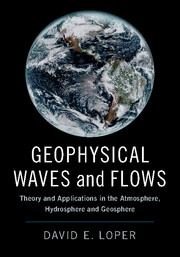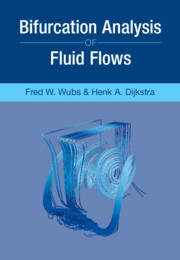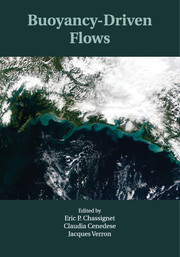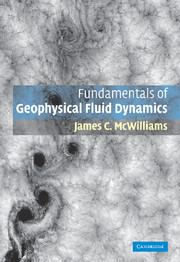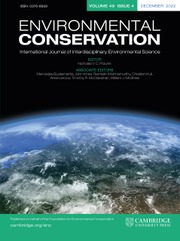Geophysical Waves and Flows
Waves and flows are pervasive on and within Earth. This book presents a unified physical and mathematical approach to waves and flows in the atmosphere, oceans, rivers, volcanoes and the mantle, emphasizing the common physical principles and mathematical methods that apply to a variety of phenomena and disciplines. It is organized into seven parts: introductory material; kinematics, dynamics and rheology; waves in non-rotating fluids; waves in rotating fluids; non-rotating flows; rotating flows; and silicate flows. The chapters are supplemented by 47 'fundaments', containing knowledge that is fundamental to the material presented in the main text, organized into seven appendices: mathematics; dimensions and units; kinematics; dynamics; thermodynamics; waves; and flows. This book is an ideal reference for graduate students and researchers seeking an introduction to the mathematics of waves and flows in the Earth system, and will serve as a supplementary textbook for a number of courses in geophysical fluid dynamics.
- Presents analytic solutions to a number of problems, enabling readers to gain an appreciation of the power of mathematical analysis in solving Earth science problems
- Footnotes cross-reference topics in different chapters and appendices, allowing readers to make connections between related topics
- Includes applications in meteorology, oceanography, hydrology and solid-Earth geophysics
Reviews & endorsements
'At last! An applied mathematician who ably explains complicated geophysical phenomena thoroughly and transparently. Read, enjoy and learn! I have.' Paul Roberts, University of California, Los Angeles
'This is a feast for mathematically literate oceanographers and atmospheric scientists and a crucial reference for established mathematicians who may be embarking on research in one of these disciplines. The amazing array of types of wave and flow is systematically analyzed by presenting them as examples of fundamental principles with shared mathematical features. The comprehensive coverage of the subject ensures both immediate usefulness and an extended life as a reference work.' Frank Stacey, formerly of CSIRO
'… a unique book … The holistic approach - of including the history, basic properties, relevance and modern usage of waves in the diverse areas of geophysics - makes the book an ideal companion for every geophysicist and a valuable resource in every library.' Ibrahim Eltayeb, Sultan Qaboos University, Oman
'This book is an important contribution to geophysics and applied mathematics. Its goal is to present a unified approach to geophysical waves and flows in a systematic manner. The omni-pervasive subject that it discusses makes it attractive for researchers both in geophysics and astrophysics. Furthermore, the structure of this volume is a multilayered one, so that it can be accessed by a variety of audiences.' Silvia De Bianchi, Mathematical Reviews
Product details
October 2017Adobe eBook Reader
9781316953020
0 pages
0kg
86 b/w illus.
This ISBN is for an eBook version which is distributed on our behalf by a third party.
Table of Contents
- Preface
- Part I. Introductory Material:
- 1. Introduction
- 2. Getting started
- Part II. Kinematics, Dynamics and Rheology:
- 3. Kinematics of deformation and flow
- 4. Dynamics and the stress tensor
- 5. Some thermodynamics
- 6. Shear rheology
- 7. Static state and perturbations
- 8. Introduction to rotating fluids
- Part III. Waves in Non-Rotating Fluids:
- 9. Introduction to waves
- 10. Elastic waves
- 11. Deep-water waves
- 12. Linear shallow-water waves
- 13. Non-linear shallow-water waves
- 14. Other non-rotating waves
- Part IV. Waves in Rotating Fluids:
- 15. Geostrophic, inertial and rossby waves
- 16. Rotationally modified waves
- 17. Equatorial waves
- 18. Coastal and topographic waves
- Part V. Non-Rotating Flows:
- 19. Orientation to one-dimensional flow
- 20. Steady channel flow
- 21. Unsteady channel flow: hydraulic shock waves
- 22. Gravitationally forced flows
- 23. A simple model of turbulent flow
- 24. Some simple turbulent flows
- Part VI. Flows in Rotating Fluids:
- 25. Ekman layers
- 26. Atmospheric flows
- 27. Oceanic currents
- 28. Vortices
- Part VII. Silicate Flows:
- 29. Equations governing silicate flows
- 30. Cooling the Earth
- 31. Cooling the mantle
- 32. Cooling the core
- 33. Overview of volcanic flows
- 34. Flow in volcanic conduits
- 35. Lava flow
- Part VIII. Fundaments: Appendix A. Mathematics
- Appendix B. Dimensions and units
- Appendix C. Kinematics
- Appendix D. Dynamics
- Appendix E. Thermodynamics
- Appendix F. Waves
- Appendix G. Flows
- References
- Index.

